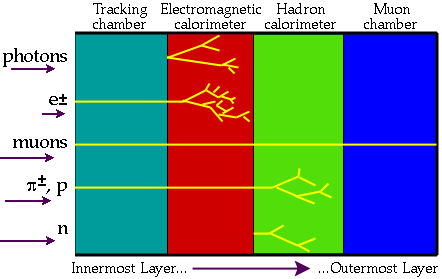Typical Components of a Detector



The reason that detectors are divided into many components is that each
component tests for a special set of particle properties.
A particle will not be evident until
it either interacts with the detector in a
measurable fashion, or decays into detectable particles.
The interaction of various particles with the different
components of a detector:

*Neutrinos are not shown on this chart because they
rarely interact with matter,
and can only be detected by missing matter and energy.
*
A few important things to note:
- Charged particles, like
electrons and protons,
are detected both in the tracking
chamber and the electromagnetic calorimeter.
- Neutral particles, like
neutrons and
photons,
are not detectable in the tracking chamber;
they are only evident when they interact with the detector.
Photons are detected by the electromagnetic calorimeter,
while neutrons are evidenced by the energy they deposit in the
hadron calorimeter.
- Each particle type has its own "signature" in the detector.
For example, if a physicist detects a particle
only in the electromagnetic calorimeter,
then he is fairly certain that he observed a photon.




